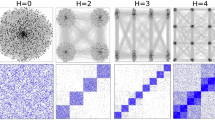Abstract
Understanding the emerging of cortical dynamical state, its functional role, and its relationship with network topology, is one of the most interesting open questions in computational neuroscience. Spontaneous cortical dynamics often shows spontaneous fluctuations with UP/DOWN alternations and critical avalanches which resemble the critical fluctuations of a system posed near a non-equilibrium noise-induced phase transition. A model with structured connectivity and dynamical attractors has been shown to sustain two different dynamic states and a phase transition with critical behaviour is observed. We investigate here which are the features of the connectivity which permit the emergence of the phase transition and the large fluctuations near the critical line. We start from the original connectivity, that comes from the learning of the spatiotemporal patterns, and we shuffle the presynaptic units, leaving unchanged both the postsynaptic units and the value of the connections. The original structured network has a large clustering coefficient, since it has more directed connections which cooperate to activate a precise order of neurons, respect to randomized network. When we shuffle the connections we reduce the clustering coefficient and we destroy the spatiotemporal pattern attractors. We observe that the phase transition is gradually destroyed when we increase the ratio of shuffled connections, and already at a shuffling ratio of 70% both the phase transition and its critical features disappear.
Access this chapter
Tax calculation will be finalised at checkout
Purchases are for personal use only
Similar content being viewed by others
References
Plenz, D., Kitai, S.: Up and down states in striatal medium spiny neurons simultaneously recorded with spontaneous activity in fast-spiking interneurons studied in cortex-striatum-substantia nigra organotypic cultures. J Neurosci. 18(1), 266–83 (1998)
Cossart, R., Aronov, D., Yuste, R.: Attractor dynamics of network UP states in the neocortex. Nature 423, 283–288 (2003). doi:10.1038/nature01614
Shu, Y., Hasenstaub, A., McCormick, D.A.: Turning on and off recurrent balanced cortical activity. Nature 423, 288–293 (2003). doi:10.1038/nature01616
Petersen, C., Hahn, T., Mehta, M., Grinvald, A., Sakmann, B.: Interaction of sensory responses with spontaneous depolarization in layer 2/3 barrel cortex. PNAS 100, 13638–13643 (2003). doi:10.1073/pnas.2235811100
Luczak, A., Barth, P., Marguet, S.L., Buzski, G., Harris, K.D.: Sequential structure of neocortical spontaneous activity in vivo. PNAS 104, 347–352 (2007). doi:10.1073/pnas.0605643104
Kinouchi, O., Copelli, M.: Optimal dynamical range of excitable networks at criticality. Nat. Phys. 2, 348–352 (2006). doi:10.1038/nphys289
Deco, G., Jirsa, V.K., McIntosh, A.R.: Resting brains never rest: computational insights into potential cognitive architectures. Trends Neurosci. 36, 268–274 (2013). doi:10.1016/j.tins.2013.03.001
Shew, W.L., Plenz, D.: The functional benefits of criticality in the cortex. Neuroscientist 19, 88–100 (2013). doi:10.1177/1073858412445487
Scarpetta, S., de Candia, A.: Neural avalanches at the critical point between replay and non-replay of spatiotemporal patterns. PLoS One (2013). doi:10.1371/journal.pone.0064162
MacLean, J.N., Watson, B.O., Aaron, G.B., Yuste, R.: Internal dynamics determine the cortical response to thalamic stimulation. Neuron 48, 811–823 (2005). doi:10.1016/j.neuron.2005.09.035
Lau P-M., Bi G-Q.: Synaptic mechanisms of persistent reverberatory activity in neuronal networks. Proc. Nat. Acad. Sci. USA 102, 10333–10338 (2005). doi:10.1073/pnas.0500717102
Ji, D., Wilson, M.A.: Coordinated memory replay in the visual cortex and hippocampus during sleep. Nat. Neurosci. 10, 100–107. doi:10.1038/nn1825 (2007)
Feng, H., Caporale, N., Yang, D.: Reverberation of recent visual experience in spontaneous cortical waves. Neuron 60, 321–327 (2008). doi:10.1016/j.neuron.2008.08.026
Luczak, A., MacLean, J.: Default activity patterns at the neocortical microcircuit level. Front Integr. Neurosci. 6, 30 (2012). doi:10.3389/fnint.2012.00030
Ribeiro, T.L., Ribeiro, S., Copelli, M.: Repertoires of spike avalanches are modulated by behavior and novelty. Front. Neural Circuits (2016). doi:10.3389/fncir.2016.00016
Gerstner, W., Kistler, W.: Spiking Neuron Models: Single Neurons, Populations, Plasticity. Cambridge University Press, Cambridge (2002)
Watts, S.: Collective dynamics of ‘small-world’ networks. Nature 393, 440–442 (1998). doi:10.1038/30918
Author information
Authors and Affiliations
Corresponding author
Editor information
Editors and Affiliations
Rights and permissions
Copyright information
© 2018 Springer International Publishing AG
About this chapter
Cite this chapter
Apicella, I., Scarpetta, S., de Candia, A. (2018). Cortical Phase Transitions as an Effect of Topology of Neural Network. In: Esposito, A., Faudez-Zanuy, M., Morabito, F., Pasero, E. (eds) Multidisciplinary Approaches to Neural Computing. Smart Innovation, Systems and Technologies, vol 69. Springer, Cham. https://doi.org/10.1007/978-3-319-56904-8_9
Download citation
DOI: https://doi.org/10.1007/978-3-319-56904-8_9
Published:
Publisher Name: Springer, Cham
Print ISBN: 978-3-319-56903-1
Online ISBN: 978-3-319-56904-8
eBook Packages: EngineeringEngineering (R0)




